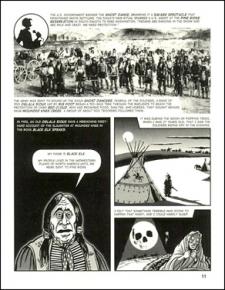Picturing resistance to empire
reviews a book that sets Howard Zinn's history from below in a new form--the graphic novel.
OVER THE past 25 years, anyone coming to radical conclusions about the U.S. and its history has likely traveled through the pages of at least one Howard Zinn book. A People's History of the United States is undoubtedly the most popular, widely read radical analysis of U.S. history.
First published in 1980, it has sold more than 1.7 million copies, become required reading in many high school and college classrooms and spawned several offshoot projects--most notably, the primary source reader Voices of a People's History of the United States.
Now, Zinn, along with cartoonist Mike Konopacki and historian and activist Paul Buhle, has delivered a new book that is sure to delight and enlighten activists, radicals and those newly come to left-wing ideas.
A People's History of American Empire is the first attempt to recreate Zinn's history in a new form--that of the graphic novel. Like the theatrical performances of Voices and the forthcoming documentary The People Speak, A People's History of American Empire uses a new medium to spread Zinn's basic message to a wider audience.
The book provides an animated, bottom-up telling of U.S. history, with a focus on U.S. military interventions and their repercussions at home.
Here, the reader discovers one of the most consciously disguised historical facts: the U.S. was not born "the world's greatest democracy," destined to spread its message of freedom around the globe. Rather, from early in its history, it has striven to become a new form of empire, time and again playing an anti-democratic role in the world.
Zinn's version of history draws out the social forces whose interests have driven the American empire--major corporations, the U.S. military, the ultra-wealthy American elite and politicians of both major parties.
From the 1890 massacre of Sioux Indians at Wounded Knee, to the funding and training of contras in Nicaragua and the predecessors of the Taliban in Afghanistan in the 1980s, the book depicts the major battles and military machinations of a U.S. ruling class bent on increasing its power and wealth, no matter what the human cost.

Zinn, Konopacki and Buhle show how the promise of American democracy has been realized only as a result of struggle against these interests, locating the source of progressive historical change where it rightly belongs--with the millions of people around the world who resisted the encroachment of U.S. empire.
Just as central are the ordinary Americans--immigrants, American Indians, slaves, workers, women, civil rights activists and others--who, throughout U.S. history, fought against injustice and inequality at home. It was the movements of these oppressed, exploited and marginalized people that won the most important social changes in history, such as women's suffrage and the end of the Vietnam War.
Finally, this history shows how organized radicals--socialists, anarchists and communists--rather than being a marginalized minority, have played a leading role in struggles for justice and democracy. The great socialist Eugene Debs, the suffragist Alice Paul, the Nicaraguan revolutionary Augusto Sandino and many others come to life in comic form.
Though the book would be worth it simply for an animated retelling of A People's History, it achieves an added layer of significance by weaving Zinn's own personal history into the narrative.
Zinn is shown growing up the son of poor Jewish immigrants in Brooklyn, N.Y.; going to demonstrations with young Communists; enlisting in the Air Force to fight fascism in Europe, only to witness (and challenge) the pernicious racism against Blacks within the U.S. military; and engaging in his later civil rights and antiwar activism as a college professor.
The comic book becomes more than just a brilliant depiction of the history of U.S. imperialism; it is also a fitting tribute to Zinn himself. Readers will gain a newfound admiration for a man whose life has spanned the majority of the past century, and whose involvement in the history goes well beyond the role of historian.
The release of this book could not be more timely. During an election year in which much is being promised, especially in regards to withdrawal from Iraq, this book serves as a reminder that the empire has never backed down except in the face of mass resistance.


